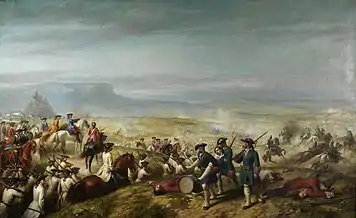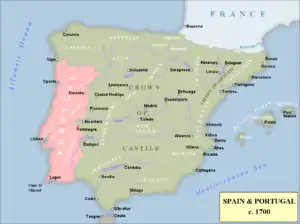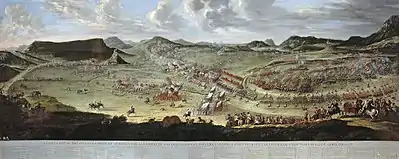Battle of Almansa
The Battle of Almansa was a campaign fought as part of the War of the Spanish Succession. It took place on 25 April 1707 between the forces of Philip V of Spain, Bourbon, claimant to the Spanish throne, and his Habsburg rival, Archduke Charles of Austria. The result was a decisive Bourbon victory that reclaimed most of eastern Spain for Philip.
| Battle of Almansa | |||||||
|---|---|---|---|---|---|---|---|
| Part of the War of the Spanish Succession | |||||||
 The Battle of Almansa by Ricardo Balaca | |||||||
| |||||||
| Belligerents | |||||||
|
|
| ||||||
| Commanders and leaders | |||||||
|
|
| ||||||
| Strength | |||||||
|
25,400 |
16,000 | ||||||
| Casualties and losses | |||||||
| 6,000 killed or wounded |
9,000 4,000 killed and wounded 5,000 captured 20 guns | ||||||

The Bourbon army was commanded by the Duke of Berwick, illegitimate son of James II of England, while Habsburg forces were led by Henri de Massue, Earl of Galway, an exiled French Huguenot. This makes it "probably the only battle in history in which the English forces were commanded by a Frenchman, the French by an Englishman."[1]
Background
Campaigning in Spain and size of the armies involved were limited by logistics to a greater extent than Flanders or Italy. Reliance on local sources for forage and other supplies limited operations in arid areas like Northern Spain, while until the advent of railways in the 19th century, goods and supplies were largely transported by water.[2] Control of the seas allowed the Allies to successfully conduct short-term offensives outside the coastal areas but lack of popular support meant they could not hold territory.
The Grand Alliance secured an operations base in Lisbon when Peter II of Portugal changed sides in May 1703, and the following March, Archduke Charles arrived to head a land campaign.[3] The Bourbons won a series of minor victories along the Spain/Portugal border, offset by the British capture of Gibraltar; attempts to retake it were defeated at the naval Battle of Málaga in August 1704, with a land siege being abandoned in April 1705.[4]
The 1705 'Pact of Genoa' between Catalan representatives and England opened a second front in the north-east; the Allied capture of Barcelona and Valencia left Toulon as the only major port available to the Bourbons in the Western Mediterranean.[5] Philip's attempt to retake Barcelona in May 1706 failed, while his absence allowed an Allied force to take Madrid and Zaragossa but they could not be resupplied so far from their bases and were forced to withdraw. By November 1706, Philip controlled the Crown of Castile, Murcia and parts of the Kingdom of Valencia.
Allied victories at Ramillies in May 1706 and Turin in September forced the French onto the defensive and Galway sought to take advantage by launching a new offensive in 1707. However, the Earl of Peterborough, Allied commander in Spain, ordered his forces in Catalonia to consolidate their position, rather than combine; when Berwick began his advance on the city of Valencia, Galway moved to intercept him but was badly outnumbered.[6]
The battle
The Bourbon army of about 25,000 contained roughly equal numbers of Spanish and French troops, as well as an Irish regiment. The bulk of Galway's army of about 16,000 were Portuguese or British with Dutch, German, and French Huguenot elements.
The Allies broke camp early on 25 April and after a long and tiring march reached the town of Almansa. Berwick had drawn up his army in two lines, just in front of the town, his infantry in the centre and the French and Spanish cavalry on the wings. Although Galway was clearly outnumbered, he commenced his attack in mid-afternoon after a short artillery exchange.
His infantry successfully drove back the Bourbon centre but a gap opened between them and Portuguese troops on the right, under the 80-year-old Marquess of Minas. Seeing this, the Franco-Spanish cavalry attacked; Berwick's account states the Portuguese fought bravely for some time but eventually collapsed and fled. Their retreat was covered by a few squadrons under Das Minas' personal command, including his mistress, who fought dressed as a man and was killed.[7]
The Allied centre was now attacked on three sides; using his remaining cavalry, Galway successfully withdrew some of his troops but 13 battalions lost contact with the rest of the army. Pursued by the Spanish cavalry, they took up a defensive position some 8 miles (12 km) from the battlefield but surrendered the next morning; two days later, Berwick invited the captured officers to a banquet.[8] Generally accepted figures put Franco-Spanish losses at around 3,000 killed, with the same number wounded, while the Allies suffered 4,000 casualties and 5,000 prisoners.[9]

Aftermath
Victory cemented the Bourbon position in Spain and gave them control of North-East Spain; by the end of 1707, the Allies were once again restricted to Catalonia and the Balearic Islands. As a result, Almansa has been described as "the single most important battle fought in Spain".[10]
The Bourbon army followed this up by besieging Xàtiva; when it surrendered in June, much of the town was destroyed and the name changed to 'San Felipe.' In memory of these events, a portrait of the monarch still hangs upside down in the local museum.
Legacy
Berwick's tactics at Almansa were admired by many, including Frederick the Great who described it as the most impressive battle of the century.[11] In addition, there is a Museo Batalla de Almansa on the site which includes a regular Battle of Almansa reenactment.
The defeat and its consequences for the autonomy of the Kingdom of Valencia and Catalonia gave rise to two modern proverbs; "De ponent, ni vent ni gent," ('From the west, neither wind nor people') and Quan el mal ve d'Almansa, a tots alcança, ('Bad news from Almansa reaches everybody').

References
- Norwich, John Jules (2007). The Middle Sea. A History of the Mediterranean. London: Chatto & Windus. ISBN 0-7011-7608-3.
- Childs, John (1991). The Nine Years' War and the British Army, 1688–1697: The Operations in the Low Countries (2013 ed.). Manchester University Press. pp. 32–33. ISBN 0719089964.
- Francis, AD (May 1965). "Portugal and the Grand Alliance". Historical Research. 38 (97): 71–93. doi:10.1111/j.1468-2281.1965.tb01638.x.
- Lynn, John (1999). The Wars of Louis XIV, 1667–1714 (Modern Wars In Perspective). Longman. pp. 296. ISBN 978-0582056299.
- Lynn, p.302.
- Kamen, Henry (2003). Spain's Road to Empire: The Making of a World Power, 1492–1763. Penguin. ISBN 978-0140285284.
- Cavendish, Richard (April 2007). "The Battle of Almanza". History Today. 57 (4).
- Kamen, Henry (2003). Spain's Road to Empire: The Making of a World Power, 1492–1763. Penguin. ISBN 978-0140285284.
- Dorrell, Nick, Hyams, Tony. "The Battle of Almanza (25th April 1707)". War Gamers UK. Archived from the original on 16 April 2017. Retrieved 3 November 2018.
- Lynn, p.316.
- Kamen, Henry (2003). Spain's Road to Empire: The Making of a World Power, 1492–1763. Penguin. ISBN 978-0140285284.
Sources
- Cavendish, Richard; The Battle of Almanza; (History Today, 2007);
- Childs, John; The Nine Years' War and the British Army, 1688–1697: The Operations in the Low Countries; (Manchester University Press, 2013);
- Francis, A.D.; Portugal and the Grand Alliance; (Journal of Historical Research, Volume 38, Issue 97);
- Kamen, Henry; Spain's Road to Empire: The Making of a World Power, 1492–1763; (Penguin, 2003 ed);
- Lynn, John; The Wars of Louis XIV, 1667–1714; (Longman, 1999);
- Norwich, John Jules; The Middle Sea; A History of the Mediterranean; (Chatto & Windus, 2007);
External links
| Wikimedia Commons has media related to Battle of Almansa. |